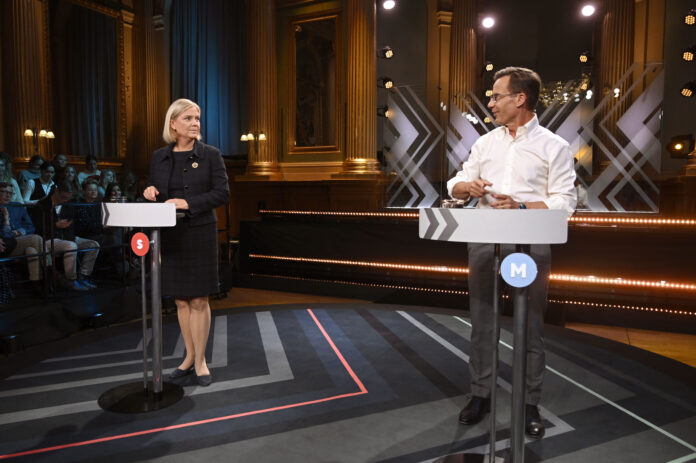Sweden is holding an election Sunday to elect lawmakers to the 349-seat Riksdag as well as to local offices across the nation of 10 million. Early voting began on Aug. 24. Here are some key things to know about the vote.
Prime Minister Magdalena Andersson is fighting to keep her center-left Social Democrats at the helm of a left-wing coalition but is facing a strong challenge from the right.
Sweden is known for being a cradle-to-grave welfare society and Andersson would like to preserve the social protections that have long defined Sweden, and reverse some of the market-oriented changes by an earlier government. Her party feels that some of the changes, like state subsidies going to private schools, are creating greater inequalities.
The once-mighty Social Democrats have been in power since 2014. But as the party’s popularity has sunk, it has presided over a weak government that relies more on other parties to pass laws, creating political instability for the past eight years.
There are two major blocs: one with four parties on the left and another with four on the right. The polls leading up to the election say it is impossible to predict.
“It’s basically a coin toss. It’s 50-50 between the two different sides,” Zeth Isaksson, a sociologist in electoral behavior at Stockholm University, said Saturday.
Under Swedish law, the party that wins the most seats forms the next government. Polls show this is likely to be Andersson’s party, which will need to create a coalition with other parties.
But if the left as a whole has a poor showing, she might not be able to form a coalition. In that case, the baton would be passed to the second-largest party to try to form a government.
In the last election in 2018, the Moderates led by Ulf Kristersson, a center-right party, won the second-highest number of seats. The conservative party promotes a market economy, lower taxes and a smaller role for government in a country with a generous welfare state supported by high taxes.
Trending Stories
Queen Elizabeth death: What’s next for Canada’s 10 days of mourning
Queen Elizabeth II: The sweetest, funniest moments from her reign
But like the Social Democrats and other mainstream parties across Europe, the Moderates have also seen their popularity decline amid a populist challenge coming from further right.
WHO ARE THE POPULISTS?
The Sweden Democrats, a populist right-wing party that takes a hard line on immigration and crime, first entered parliament in 2010 and has been growing steadily ever since.
The party won 13% of the vote in 2018, becoming the third-largest force in parliament. Polls show it is likely to improve on that showing Sunday.
Some Swedes compare the party to Trump-style populism and note it was founded by far-right extremists decades ago. They do not trust it in its reported transformation to a more traditional conservative party.
The party is led by Jimmie Akesson, a 43-year-old former web designer who has been the driving force in trying to moderate the party’s image.
The party has clearly tapped into the social mood, however, and other parties have been moving closer to its positions, as many Swedes believe that they can no longer bear the costs of the country’s generous refugee policies and are seeking a crackdown on crime.
Once a pariah, other conservative parties have grown increasingly willing to deal with the Sweden Democrats.
Andersson told reporters Saturday that “the rise of the far right” was partly the fault of the right-wing opposition, which she said “spent so much time and effort to try to convince people that the Sweden Democrats aren’t the party that they actually are.”
Some immigrants have had difficulties assimilating into Swedish society, leading to segregated neighborhoods with high crime rates.
Gang violence mostly takes place among criminal networks dealing drugs or involved in other illicit activity. But there have been recent cases of innocent bystanders being hurt. So far this year, 48 people have been killed by firearms in Sweden, three more than in all of 2021.
The fears triggered by shootings and explosions in disadvantaged neighborhoods have made crime one of the most pressing issues for Swedish voters.
“Shootings and explosions of bombs have increased in the last few years and (this violence) is now considered a great social problem,” said Anders Sannerstedt, a political scientist at Lund University in southern Sweden.
Andersson became Sweden’s first female prime minister less than a year ago _ a milestone late in coming for a country that in many ways is an example of gender equality.
“I was really proud,” said Ulrika Hoonk, a 39-year-old who voted early in Stockholm on Friday, saying it took “far too long” for that to happen.
Polls show that Andersson’s party is especially popular with women, with men tending to vote more conservative.
Even though Andersson is the first prime minister, there are still many women represented in positions of authority. Four party leaders are women and one party has a woman and a man sharing the leadership. In parliament, the gender balance has long been split roughly 50-50.
Several women voters interviewed this week said that finally having a woman in the top leadership job was very important for them, and one factor they considered when choosing which party to support.
___
Jan M. Olsen in Copenhagen, Denmark, contributed.
© 2022 The Canadian Press



